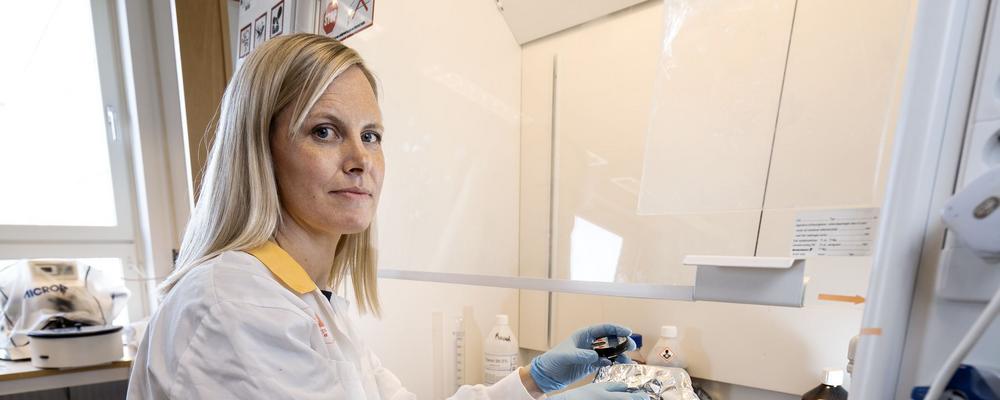
- Home
- Research
- Find research
- Linda Engström Ruud to receive starting grant from the Novo Nordisk Foundation
Linda Engström Ruud to receive starting grant from the Novo Nordisk Foundation
GRANT. Linda Engström Ruud will receive just over SEK 13 million over the next five years from the Novo Nordisk Foundation for a project that may improve treatment of obesity and diabetes with GLP-1 receptor agonists. She is also studying how the brain regulates involuntary undereating.

She is receiving the Excellence Emerging Investigator Grant within Endocrinology and Metabolism, which the Novo Nordisk Foundation only gives to a few applicants in the entire Nordic region each year. The grant will allow Linda to begin establishing her research team.
“I cannot emphasize enough how much this grant means to me. It is giving me the opportunity to truly become established as an independent researcher, and I’ll be able to hire a few people and buy the necessary equipment. In addition, of course, it’s also evidence that the research I want to do is meaningful and of high quality.”
This is her second prestigious grant in a short time. Last autumn, she received the Swedish Research Council’s coveted starting grant, which will pay her salary for the next four years.
Gothenburg, Linköping, Cologne
With her sights set on research early on, Linda completed her undergraduate degree here in Gothenburg, in what was the bioscience pharmaceutical program at that time. She completed her doctoral degree on how the autonomic nervous system regulates disease responses, such as fever and anorexia, in Linköping. As a doctoral student, she met her future husband Johan Ruud, who works with related research questions and who also became an important partner for her research. They were postdocs together in Cologne, Germany at a large laboratory at the Max Planck Institute for Metabolism Research. Led by Professor Jens Brüning, around 15 postdocs and 10 doctoral students work at the laboratory, studying topics such as how the brain governs peripheral glucose metabolism and food intake.
“I worked hard and really wanted to make the most out of this great opportunity. Among other things, I got an article published in Nature Communications,” explains Linda, who describes the three active years as postdocs in Cologne as fun and educational.
“The people in the lab were really nice and the pace was quick, and I learned a lot about new methods and research strategies. Above all, I brought back methods that make it possible to functionally study neuronal circuits in the brain. These methods make it possible to study causal relationships between activation or inhibition of a circuit and how this impacts e.g. food intake or the development of an aversion to a certain food. They will form the basis of my approach to the research questions I’m interested in here in Gothenburg.”
Involuntary undereating
Since January this year, Linda has had a research position at the Section of Endocrinology at the Institute of Neuroscience and Physiology at the University of Gothenburg. For her Swedish Research Council project, she is studying a structure in the brain called the Bed Nucleus of the Stria Terminalis (BNST), which is connected to negative emotions like stress, anxiety and fear, but also to food intake. The project will enhance understanding of the role of the brain structure in regulating loss of appetite and aversion to food and how the structure communicates with other parts of the brain. This project is relevant to how the brain regulates involuntary undereating and weight loss, which can be a problem in chronically ill patients undergoing treatment for various forms of cancer, for example.
Mechanisms behind weight loss drugs
The project for which she has now received funding from the Novo Nordisk Foundation relates to how the brain regulates food intake as well, but with a clearer focus on endocrinology and metabolism.
“There are now several long-acting drugs that impact the receptor for GLP-1 and that demonstrate significant results for both weight loss and glycemic control with type 2 diabetes. The weight loss is due to decreased appetite, but we do not quite understand how these drugs affect the brain to achieve this effect. In addition, a common side effect of these drugs is nausea, and as a result, not everyone can tolerate the treatment.
The project that the Novo Nordisk Foundation is funding will be based partly on methods I learned in Cologne, but also on a new methodological infrastructure that Johan and I have worked hard to establish together here in Gothenburg.”
Her research will take a brand-new approach to molecular identification and functionally connecting the nerve cells that are activated by long-acting GLP-1R agonists to the effects of these substances.
“If we can learn more about which nerve cell groups are involved in the desired drug response related to appetite and the undesired nausea, it could be possible to develop even better drugs in the future, with less pronounced side effects,” says Linda, whose project will also contribute valuable fundamental information about the neuronal circuits in the brain that govern food intake.
BY: ELIN LINDSTRÖM
PHOTO: JOHAN WINGBORG
